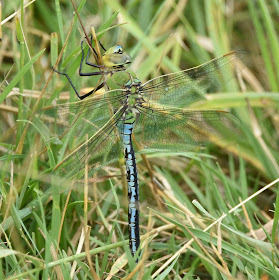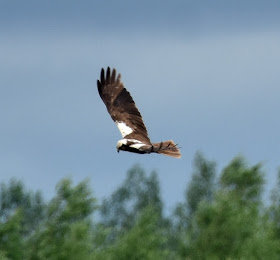Otmoor - The ones that got away July 2020
by Peter Barker
by Peter Barker
We have all spent time speculating what we might have missed whilst we were in lockdown and the Reserve was strictly off limits. We can now reveal that we certainly missed two excellent birds on Otmoor, one of which was a first ever record for Oxfordshire and the other a very much less than annual visitor.
David Wilding, the reserve manager and the only member of Otmoor RSPB staff not furloughed, was out in the early morning of 25th May checking pumps and water levels on the bund that separates the two halves of the reedbed. He heard a reeling coming from out in the northern section and knew at once that, although somewhat similar to a Grasshopper Warbler, this was very different. He also knew that it could only be a Savi’s Warbler. He realised that this was a very important discovery and that he needed to confirm it. He shot a piece of video on his mobile phone which although not showing the bird, clearly recorded the hard, dry reeling song. He sent the video straight away to Jon Uren who keeps the O.O.S. records and is an Otmoor volunteer. Jon in turn sent the clip on to Ian Lewington for final confirmation, it was as they had believed a Savi’s Warbler. Unfortunately there was no way that this information could be released, not only was the bird singing from inside the closed reserve, but it was singing from a part of the reserve that is not accessible to the public even when the site is fully open. David kindly offered both Ian and Jon the opportunity to come out and hear it but they both very honourably declined, saying that it would not be fair to all the other county birders, who would not be able to visit due to lockdown and with the site being formally closed.
Reeling Savi's Warbler - note the higher pitch that Grasshopper Warbler
The RSPB runs a number of trail cameras around the reserve to monitor fox, badger and deer movements. One of the cameras, out near the south eastern edge of the reedbed, picked up the unmistakeable and distinctive “whip “ call of a Spotted Crake, almost every time that it was triggered by passing animals. These recordings ran from the 1st through to the 7th April, when staff were furloughed, and monitoring stopped. The bird was certainly holding territory and may well have attracted a mate. Sadly, we will never know!
Spotted Crake on the Trail Cam
So there we have the two that got away, at least the two we know about…………….and we can only wonder about what else could have slipped under the radar.

































































